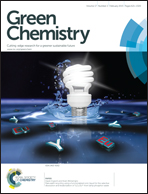Selective aerobic oxidation of the biomass-derived precursor 5-hydroxymethylfurfural to 2,5-furandicarboxylic acid under mild conditions over a magnetic palladium nanocatalyst
Abstract
A new method for the selective aerobic oxidation of 5-hydroxymethylfurfural (HMF) into 2,5-furandicarboxylic acid (FDCA) has been developed employing a magnetically separable [γ-Fe2O3@HAP-Pd(0)] catalyst. The catalyst was prepared by the exchange of Pd2+ with Ca2+ in γ-Fe2O3@HAP, followed by reduction of the Pd2+ to Pd(0) nanoparticles, and well characterized by TEM, XRD and XPS. The catalyst showed high activity in the oxidation of HMF to FDCA in water, with 97% HMF conversion and a 92.9% yield of FDCA under optimal reaction conditions. The method developed has demonstrated some advantages, including its sole requirement of a stoichiometric base, and high catalytic performance under atmospheric oxygen, even in air. More importantly, the γ-Fe2O3@HAP-Pd(0) catalyst was readily separated from the reaction solution using an external magnetic field and was successfully reused during five consecutive reaction runs while retaining its catalytic effectiveness. This study provides a green and sustainable method for the production of valuable chemicals from renewable resources.


 Please wait while we load your content...
Please wait while we load your content...